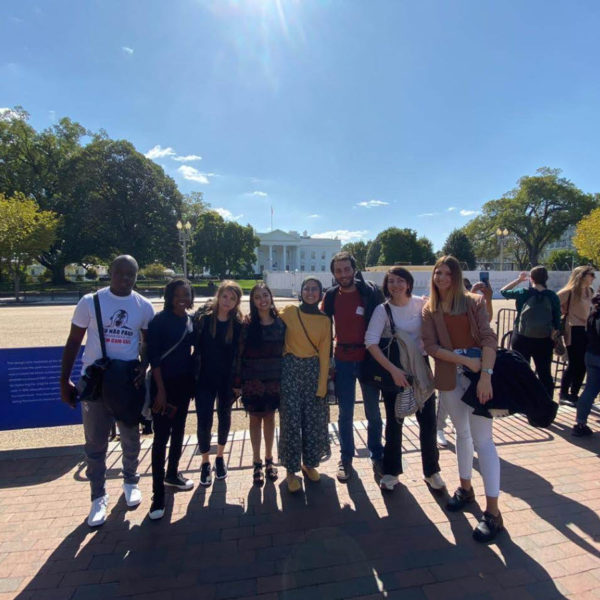Downtown Washington D.C, a couple of minutes away from the White House, a place to be if you are into corporate lobbying. Somewhere you would least expect typical iDEC (read independent Director, Editor and Camera Operator) to hang out. But this warm October weekend was different. On the corner of 12th and K, hipster-heaven hotel with its radio station spreading groovy energy throughout welcomed an interesting bunch. Filmmakers, journos, cinematographers gathered on Double Exposure Film Festival to discuss the future of investigative film.
And a lot was said.
Experienced movie makers revealed how to build connections with people they are filming, what are the legal and human boundaries of these relationships. The authors reminded the crowd that documentaries don’t have subjects and topics, but rather people and their lives. We learned about the gentle power of sound and its rebirth in podcasts. A lot was said about gender, race and environmental issues local communities face throughout the world regardless of their social and economic backgrounds.
But the question I was seeking to find the answer was – In the world used to seeing endless streams of images what journalists/moviemakers can do to make accuracy pop up? How to find a picture that represents the situation the best?
The Intercept – visual evidence state of mind
“You should think about what kind of visual evidence you can collect along the way while working on the story”, Lauren Feeny, video journalist for The Intercept emphasized while explaining how we should make videos. Her point was that visual investigations require proofs the same as investigative reporting requires documents to support the claims in the article.
Surveillance camera footage or voice memos are just some of them. This approach was used in the ICE and Isolation: A Portrait of Torture in Immigration Detention, a video explaining conditions that led a 40-year-old Mexican immigrant with schizophrenia to commit suicide.
The story was told through the state investigators’ audio interviews with medical and correctional staff as well as other men held in the same solitary confinement cell block. They used security camera footage as video coverage. Journalists obtained video and audio materials from the Detention Center.
As Feeny was giving her final tip – don’t be afraid to ask for video/audio materials from people you meet while working on the story – I wondered what other filmmakers consider to be their ‘visual evidence’.
From archival to exclusive access
I started my research on the pitch session where authors show their ‘work-in-progress’ movies in front of the expert audience. There were many different ways to investigate visually.
Anne Alvergue and Debra McClutchy were driven by the archival when they decided to make a film about Martha Mitchel, vivid women involved with the Watergate scandal and wife of the Attorney General at the time. Martha’s comfortable life was interrupted after she recognized one of the Watergate burgers and started talking about it.
Ann and Debra started unwinding the story by prioritizing the archival. Ms. Mitchel liked the press so they had tons of newspapers, headlines that would help them tell her story. „We knew that she talked to the press a lot, there were a lot of audio interviews and video interviews. It’s all about having the visuals, if you don’t have the visuals, you don’t have the film. Write the article instead.“, Anne Alvergue explained.
The authors are still working on the film with the clear aim – tell the story told through her voice as much as possible.
Andalusia Knoll Soloff, director of Poppy Crash is an investigative journalist that arrives first on the scene. This was the case when she started researching the effects of fentanyl crisis on the poppy producers in Mexico, in the small indigenous town in the state of Guerrero.
She explained this documentary required “going into communities where no one from the outside goes”.
Andalusia explained the economy crash among poppy farmers through the first-hand experience. “Showing a store that used to be fully stalked with nothing in it, with a list of all the people that owe money because there’s no longer any money in the community from selling poppy and opium”, was one of the scenes she used in the film. She backed up what I saw on the fields with factual evidence and reports from local think-thanks.
People need to care!
“You need to have two hats on. Think about the questions you ask yourself when entering into a regular investigation and then think about what can a visual show you. If people can’t see it, they can’t understand it. And people need to care” – this was an important lesson Maren Machles learned while working on A Broken Trust: Sexual Assault And Justice On Tribal Lands.
Maren explained how sexual violence on tribal lands and the struggles indigenous survivals face when they are trying to report it dates back through all of US history. It took a lot of building trust and bring cameras to these communities.
This helped me understand that finding the picture that represents the situation the best is finding a picture everyone can relate to. What better way to make the people care then showing them the truth.


